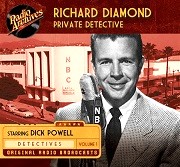
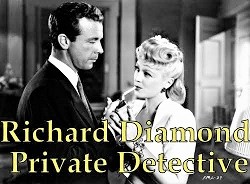 Richard Diamond, Private Detective (1949-52) aired “The Man with the Scar” on January 19, 1951 as its 79th of some 141 original episodes. This is only the sixth Richard Diamond episode we’ve presented, the first being from early November of 2019 and the last just over a year ago in June of 2022. Due to the popularity of the earlier shows I thought it might be a good idea to offer Diamond fans with another, especially since it’s been over a year since the last one. Therefore–-for newcomers to the show and those wishing to refresh their memories–-I reprise in slightly abbreviated form our earlier historical sketch of the program and its recurring characters.
Richard Diamond, Private Detective (1949-52) aired “The Man with the Scar” on January 19, 1951 as its 79th of some 141 original episodes. This is only the sixth Richard Diamond episode we’ve presented, the first being from early November of 2019 and the last just over a year ago in June of 2022. Due to the popularity of the earlier shows I thought it might be a good idea to offer Diamond fans with another, especially since it’s been over a year since the last one. Therefore–-for newcomers to the show and those wishing to refresh their memories–-I reprise in slightly abbreviated form our earlier historical sketch of the program and its recurring characters.
The show originally aired over NBC stations, then ABC, and then finally in 1953 by CBS, but all of the CBS shows were repeats from the 1950-51 season, thus some old time radio sites list the show’s run as going into 1953. Richard Diamond (starring film icon Dick Powell, 1904-1963) was an ex-cop turned private detective who maintained good relations with his ex-boss and police lieutenant Walter Levinson (played by Ed Begley [1901-1970], probably most well remembered as juror #10 in the classic 1957 film Twelve Angry Men, and father to actor Ed Begley, Jr.). Diamond’s girlfriend, Helen Asher, was played by Virginia Gregg (1916-1986, photo below with Powell), who went on to have many film and television roles (including the Twilight Zone episode “The Masks” which aired March 20, 1964). The character of Richard Diamond–-and the radio program itself–-was the brainchild of Blake Edwards (1922-2010), perhaps best known for writing and directing the Pink Panther movies, as well as directing other fine films such as Operation Petticoat (1959), Breakfast at Tiffany’s (1961), and Days of Wine and Roses (1962). Blake’s private detective Richard Diamond didn’t exactly fit the standard mold people were used to, as typified in the novels of Dashiell Hammett and Raymond Chandler. While he could wisecrack with the best of them, he was also suave and sophisticated and tough as nails, living the high life in New York City when not found visiting the swank penthouse apartment of his girlfriend, Helen Asher. Being a well-seasoned song and dance man due to his many early movies where he inevitably ended up singing, Dick Powell was the perfect choice to play Richard Diamond, especially after his smashing success in 1944’s Murder, My Sweet. Audiences loved Powell as Diamond, so much so that the show’s popularity warranted its own television counterpart. It starred David Janssen (1931-1980) and ran from 1957-1960. Janssen, of course, is best remembered for his iconic role as Dr. Richard Kimble in the classic TV series The Fugitive (1963-67).
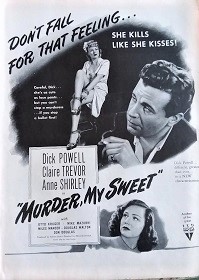 Dick Powell’s breakout film (briefly mentioned above) was 1944’s noir classic Murder, My Sweet. Based on Raymond Chandler’s detective character Philip Marlowe from his 1940 novel Farewell, My Lovely, the film was released with the book’s title but audience reaction was tepid at best, the feeling being that the title wasn’t dark enough and audiences assumed it was just another of Powell’s many light romances he had been making since the 1930s (30+ such roles from 1932-1939), in which he played handsome young men who wooed women with his boyish good looks, musical ability, and crooning voice. Getting older, and desirous of more mature roles that fit his middle aged demeanor, he convinced the powers that be to give him the role of Marlowe from Chandler’s novel. It was quite a gamble but Powell pulled it off admirably and the film is now recognized as a noir classic. When the film was released in late December of 1944 with the novel’s title and proved unsuccessful at the box office, it was quickly retitled Murder, My Sweet and re-released in February of 1945 in St. Louis with much better results. The box office and critical acclaim following the film led to several other noir films of note with Powell in the lead: Johnny O’Clock (1947, in which he played a detective), To the Ends of the Earth (1948, crime noir), and Pitfall (also 1948, film noir where he starred as a bored insurance agent who falls in love with the wrong woman).
Dick Powell’s breakout film (briefly mentioned above) was 1944’s noir classic Murder, My Sweet. Based on Raymond Chandler’s detective character Philip Marlowe from his 1940 novel Farewell, My Lovely, the film was released with the book’s title but audience reaction was tepid at best, the feeling being that the title wasn’t dark enough and audiences assumed it was just another of Powell’s many light romances he had been making since the 1930s (30+ such roles from 1932-1939), in which he played handsome young men who wooed women with his boyish good looks, musical ability, and crooning voice. Getting older, and desirous of more mature roles that fit his middle aged demeanor, he convinced the powers that be to give him the role of Marlowe from Chandler’s novel. It was quite a gamble but Powell pulled it off admirably and the film is now recognized as a noir classic. When the film was released in late December of 1944 with the novel’s title and proved unsuccessful at the box office, it was quickly retitled Murder, My Sweet and re-released in February of 1945 in St. Louis with much better results. The box office and critical acclaim following the film led to several other noir films of note with Powell in the lead: Johnny O’Clock (1947, in which he played a detective), To the Ends of the Earth (1948, crime noir), and Pitfall (also 1948, film noir where he starred as a bored insurance agent who falls in love with the wrong woman).
Powell was also active in television as actor, director, and producer. Arguably his best known TV endeavor was Dick Powell’s Zane Grey Theater or as it came to be known, simply Zane Grey Theatre (1956-1961). It was a western anthology series based on the works of Zane Grey, but as time went on new material was added to keep the stories fresh. It guest-starred many of the most well known or beloved and/or major TV/movie stars of the day, including but not limited to: Anne Bancroft, Robert Blake, Ernest Borgnine, Lloyd Bridges, Claudette Colbert, Hedy Lamarr, Julie London, Ginger Rogers, James Garner, Dennis Hopper, Burl Ives, Michael Landon, Edward G. Robinson, Jack Lemmon, David Niven, John Dehner, Burt Reynolds, Lon Chaney, Jr., Barbara Stanwyck, and many more. Much beloved in Hollywood and throughout the country by his legion of fans, Dick Powell died on February 3, 1963. His widow, well known actress June Allyson, gave his cause of death as lung cancer due to his chain smoking. Powell has a star on the Hollywood Walk of Fame.
As many of Richard Diamond’s episodes do, this one begins with his trademark whistling and a phone call. This caper is what I would call more or less routine, a no frills, meat and potatoes assignment, but nicely drawn and executed nevertheless. The opening scene sees Diamond “tuned up” but good by a pair of ugly thugs who warn him to ignore the phone call he will soon receive if he knows what is good for him. The storyline is fairly basic: the inmate buddy of the unfriendly thugs who visited Diamond is up for parole in the very near future. To tip the odds in his favor they are blackmailing the head of the parole board in the hope he will have a major positive influence on their friend’s upcoming parole. It seems the head of the parole board’s son is in some trouble and the bad guys will expose him if the head of the parole board doesn’t grant their buddy’s parole. Diamond’s services are retained for a substantial fee. He is to find and thwart the blackmailers with time being of the essence, thus removing their threat to expose the head of the parole board’s son–who may or may not even be guilty of a crime. A pretty straightforward case as these things go, but the devil is in the details, and part of the details this time around of course involve a drop-dead gorgeous dame and the titular “Man with the Scar.” Favorite line of dialogue in the best Chandleresque mold: “She looked like a fat woman eyeing a French pastry.” Have fun with this one.
[Left: Murder, My Sweet poster – Right: Virginia Gregg & Dick Powell]
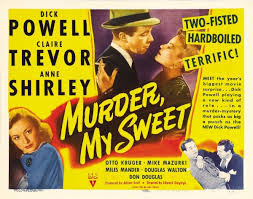
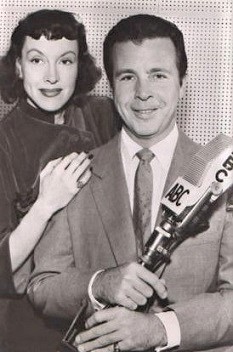
(Linked CD at top includes this episode and 19 others.)
Play Time: 29:33
{This episode aired on a Friday night, but the neighborhood gang wanted more of the same so found themselves at the nearby newsstand the next morning nickels and dimes jingling in their pockets for the last time, for SF and Detective pulps were beckoning with their siren calls of danger and adventure, those things young boys could not easily resist. Future (combined with) Science Fiction (1950-54) had a complicated history and many name changes, including a name change simply to Future Science Fiction in January of 1952. It would then take yet another new name in 1955, but under its primary Future Science Fiction title it would see 27 issues before folding in October of 1954. It was a bi-monthly for its entire run, though it produced only 5 issues in 1954. Other Worlds Science Stories (1939-53) was Raymond Palmer’s attempt to produce a counterpart magazine to his already well-established UFO/Unexplained magazine Fate. Palmer dropped the “science stories” part of the title in 1952. The magazine never held to any set schedule and in 1951 published 7 issues. Thrilling Detective (1931-53) would see an amazing 213 issues before folding in 1953, no doubt one of many pulps feeling the effect of the major distribution collapse at that time. For most of its lifespan it was a monthly until the end of 1945, then cut back to a bi-monthly from 1946-51. Its final two years would see only 9 issues.}
[Left: Future SF, 1/51 – Center: Other Worlds, 1/51 – Right: Thrilling Detective, 2/51]
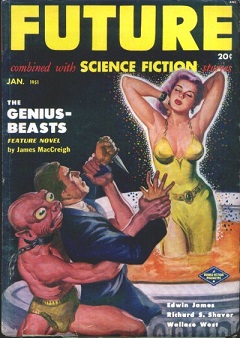
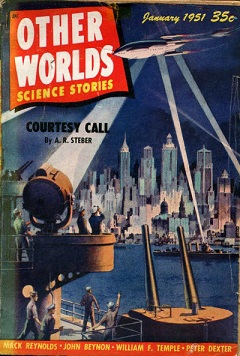
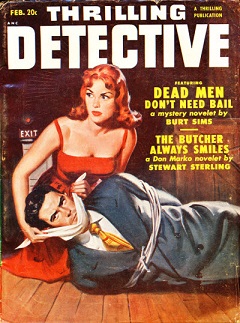
To view the entire list of weekly Old Time Radio episodes at Tangent Online, click here.